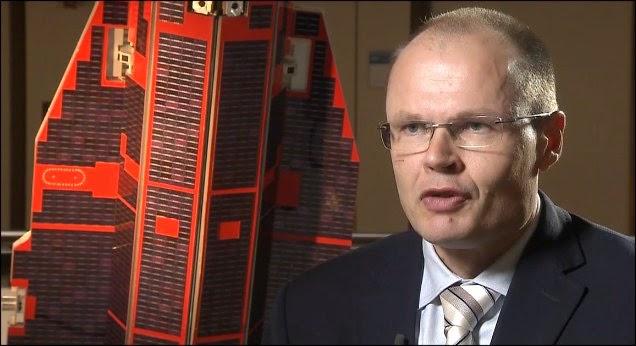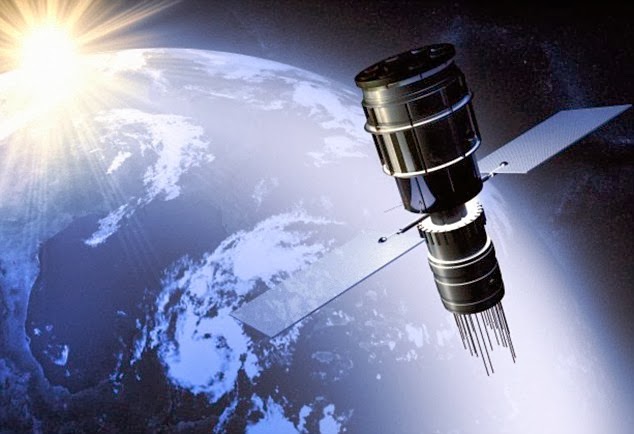The ocean currents and their speeds (in cm/s) derived from ESA's GOCE data.
During the mission’s final year, its super-low orbit was lowered even further to obtain improved measurements of Earth’s gravity field, from which information on ocean currents was derived.
Buoys floating in the oceans were used to validate the above map, proving that this GOCE-based model is more accurate than any other model based on space-based data to date.
Credit: ESA
The mean dynamic topography (MDT, in cm) of the world’s oceans in the highest resolution ever achieved from space-based data.
MDT is calculated by taking the mean sea-surface height measured by satellites like Envisat, and subtracting the gravity model from GOCE.
Red areas show where water levels are above the surface of the gravity model, while blue depicts areas where the water is below. From this, scientists calculated the speed of ocean currents.
A year after the satellite reentered the atmosphere, scientists using data from the GOCE satellite have made a breakthrough in our understanding of ocean currents.
The Gravity field and steady-state Ocean Circulation Explorer (GOCE), mapped variations in Earth’s gravity with unrivalled precision, resulting in the most accurate shape of the ‘geoid’ – a hypothetical global ocean at rest – ever produced.
While the mission is well known for its gravity measurements, the second mission objective as an ‘ocean circulation explorer’ has reached a milestone.
Using GOCE data, scientists have produced the most accurate model of ocean current speeds to date.
To do this, the GOCE geoid was subtracted from the mean sea-surface height measured over a 20-year period by satellites including ESA’s veteran Envisat.
In 2011, GOCE delivered a model of the 'geoid' pictured here. At the time, it was the most accurate ever produced.
The colours in the image represent deviations in height (–100 m to +100 m) from an ideal geoid.
The blue shades represent low values and the reds/yellows represent high values.
Credit: ESA
The result shows the mean dynamic topography of the ocean surface, showing higher- and lower-than-average water levels. Based on this map, ocean currents and their speeds were calculated and validated using in situ buoys.
The result shows that this GOCE-based model is more accurate than any other model based on space data to date.
“The accurate estimate of ocean surface currents, as provided today by the combination of GOCE and altimetry data, is crucial for the better understanding of the ocean dynamics,” said Marie-Hélène Rio from the Institute of Atmospheric Sciences and Climate of the Italian National Research Council.
“In particular, the assimilation of this information into operational ocean monitoring and forecasting systems will provide highly valuable new insight into the present and future state of the ocean.”
This was just one of many GOCE results presented today at the opening of the 5th International GOCE User Workshop at the UNESCO Headquarters in Paris, France.
During the mission’s final year, its super-low orbit was lowered even further to obtain improved measurements of Earth’s gravity field, from which information on ocean currents was derived.
Buoys floating in the oceans were used to validate the above map, proving that this GOCE-based model is more accurate than any other model based on space-based data to date.
Credit: ESA
The mean dynamic topography (MDT, in cm) of the world’s oceans in the highest resolution ever achieved from space-based data.
MDT is calculated by taking the mean sea-surface height measured by satellites like Envisat, and subtracting the gravity model from GOCE.
Red areas show where water levels are above the surface of the gravity model, while blue depicts areas where the water is below. From this, scientists calculated the speed of ocean currents.
A year after the satellite reentered the atmosphere, scientists using data from the GOCE satellite have made a breakthrough in our understanding of ocean currents.
The Gravity field and steady-state Ocean Circulation Explorer (GOCE), mapped variations in Earth’s gravity with unrivalled precision, resulting in the most accurate shape of the ‘geoid’ – a hypothetical global ocean at rest – ever produced.
While the mission is well known for its gravity measurements, the second mission objective as an ‘ocean circulation explorer’ has reached a milestone.
Using GOCE data, scientists have produced the most accurate model of ocean current speeds to date.
To do this, the GOCE geoid was subtracted from the mean sea-surface height measured over a 20-year period by satellites including ESA’s veteran Envisat.
In 2011, GOCE delivered a model of the 'geoid' pictured here. At the time, it was the most accurate ever produced.
The colours in the image represent deviations in height (–100 m to +100 m) from an ideal geoid.
The blue shades represent low values and the reds/yellows represent high values.
Credit: ESA
The result shows the mean dynamic topography of the ocean surface, showing higher- and lower-than-average water levels. Based on this map, ocean currents and their speeds were calculated and validated using in situ buoys.
The result shows that this GOCE-based model is more accurate than any other model based on space data to date.
“The accurate estimate of ocean surface currents, as provided today by the combination of GOCE and altimetry data, is crucial for the better understanding of the ocean dynamics,” said Marie-Hélène Rio from the Institute of Atmospheric Sciences and Climate of the Italian National Research Council.
“In particular, the assimilation of this information into operational ocean monitoring and forecasting systems will provide highly valuable new insight into the present and future state of the ocean.”
This was just one of many GOCE results presented today at the opening of the 5th International GOCE User Workshop at the UNESCO Headquarters in Paris, France.







































